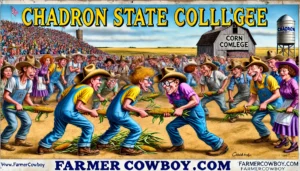
Rare Vegetable A humorous and detailed close up illustration in the style of Mad Magazine depicting an exotic vegetable Crosne. The scene shows the vegetable with a3.webp.webp
Crosne: The Knobby Treasure from the East
In the bustling marketplace of vegetables, where familiar faces like carrots and potatoes vie for attention, a quirky and exotic contender is making its way to the forefront. Meet Crosne (Stachys affinis), also known as Chinese artichoke. This knobby little tuber hailing from China and Japan is ready to revolutionize your culinary experience with its crisp texture and nutty flavor.
The Rise of Crosne
Crosne is a small, knobby tuber that looks like it belongs in a science fiction movie rather than on your dinner plate. Originating from China and Japan, Crosne is not your average vegetable. Its unique appearance and delightful crunch make it a standout in the world of root vegetables.
“Crosne is like the mini dinosaur of vegetables,” jokes food historian Dr. Crunchy Tuber. “It’s knobby, it’s crunchy, and it’s got a flavor that takes you by surprise.”
Despite its intriguing characteristics, Crosne remains a rare find in mainstream markets. Limited commercial cultivation means that Crosne is often found only in specialty stores, making it a prized ingredient for chefs and adventurous eaters.
The Culinary Potential of Crosne
With its crisp texture and nutty flavor, Crosne is a versatile ingredient that can add a delightful crunch to a variety of dishes. It can be sautéed, stir-fried, pickled, or even eaten raw. Its unique texture makes it a perfect addition to salads, stir-fries, and appetizers.
“Crosne is a game-changer in the kitchen,” says Chef Snout. “Its crisp texture adds a refreshing crunch to dishes, and its nutty flavor pairs well with a variety of ingredients.”
However, cooking with Crosne is not without its challenges. Its small, knobby shape can make it difficult to clean and prepare. But for those who master the art of cooking with Crosne, the rewards are well worth the effort.
Farmers Contemplating Growing Crosne: A Guide
For farmers considering the plunge into growing Crosne, be prepared for an adventure filled with crunchy surprises. Here’s a guide to help you navigate the whimsical world of Crosne farming.
1. The Knobby Garden: Crosne’s unique appearance means your farm will look like a scene from a sci-fi movie. Be prepared for curious visitors asking about your alien crop.
2. Crunchy Challenges: Crosne’s knobby shape might attract all sorts of critters. Consider installing mini force fields to keep them at bay.
3. Exotic Appeal: Growing Crosne will make you the talk of the town. Prepare for gourmet chefs knocking on your door, begging for a taste of your crunchy treasure.
4. Culinary Challenges: Experiment with different cooking methods to find the perfect balance of flavor and texture. Don’t be afraid to get creative—Crosne is all about adding a unique twist to your dishes.
5. Limited Edition: Market your Crosne as a limited-edition vegetable. Its rarity and unique flavor make it the perfect candidate for a culinary adventure.
The Crosne Revolution
As more chefs and food enthusiasts discover the magic of Crosne, this knobby tuber is poised to revolutionize the culinary world. Its unique texture and nutty flavor make it a standout ingredient that’s impossible to ignore.
“Crosne is the vegetable equivalent of a hidden gem,” says food critic Nutty Crunch. “It’s got the texture, the flavor, and the novelty to take the culinary world by storm.”
With its rising popularity, Crosne is no longer content to be a hidden gem. It’s stepping into the spotlight, ready to dazzle and delight anyone who takes a bite.
Conclusion: Embracing the Knobby Treasure
In conclusion, Crosne is not just a vegetable—it’s a culinary experience. From its knobby appearance to its crisp texture, Crosne brings a burst of nutty flavor to any dish. As more people embrace this exotic tuber, the culinary landscape will be forever changed.
So the next time you come across Crosne in a specialty market, don’t hesitate to give it a try. Let its unique texture and nutty flavor take you on a culinary adventure you won’t soon forget.
Disclaimer
This article is a human collaboration between a cowboy and a farmer. No tubers were harmed in the making of this article, although several did enjoy a bit of extra seasoning. Always consult a culinary expert before attempting to cook with rare vegetables. Remember, tubers are for eating, not just for admiring.
15 Humorous Observations About Crosne (Stachys affinis)
- Crosne is like the mini dinosaur of vegetables—knobby, crunchy, and full of surprises.
- If Crosne could talk, it would probably tell stories of its sci-fi adventures.
- Crosne looks like it belongs in a sci-fi movie, but it tastes like a nutty treasure.
- Eating Crosne is like finding a crunchy gem in your salad.
- Crosne’s knobby shape is its way of saying, “I’m unique and proud of it.”
- If Crosne were a party guest, it would be the one bringing exotic snacks and alien tales.
- Crosne thinks it’s the star of the vegetable world, and with that crunch, who can argue?
- The only thing missing from Crosne’s knobby look is a spaceship to complete its sci-fi vibe.
- Crosne’s idea of a perfect day is being the crunchiest part of a gourmet dish.
- If Crosne were a character in a movie, it would be the quirky sidekick with all the best lines.
- Crosne’s nutty flavor is its way of saying, “I’m not just a pretty face—I’ve got substance too.”
- If Crosne had a fashion show, its knobby appearance would be all the rage on the runway.
- Crosne’s crunchy texture makes it the life of any culinary party.
- The only thing Crosne loves more than being knobby is being the star ingredient in a dish.
- If Crosne had a fan club, it would be filled with adventurous eaters and sci-fi enthusiasts.
Originally posted 2011-01-05 21:06:58.
Originally Published at FarmerCowboy.com
2024-09-08 22:12:53
Karl Hoffman is a distinguished agriculturalist with over four decades of experience in sustainable farming practices. He holds a Ph.D. in Agronomy from Cornell University and has made significant contributions as a professor at Iowa State University. Hoffman’s groundbreaking research on integrated pest management and soil health has revolutionized modern agriculture. As a respected farm journalist, his column “Field Notes with Karl Hoffman” and his blog “The Modern Farmer” provide insightful, practical advice to a global audience. Hoffman’s work with the USDA and the United Nations FAO has enhanced food security worldwide. His awards include the USDA’s Distinguished Service Award and the World Food Prize, reflecting his profound impact on agriculture and sustainability.






